Thunderbolt 3 in Action: Akitio Thunder3 Duo Pro DAS Review
by Ganesh T S on April 14, 2016 8:30 AM EST- Posted in
- Storage
- DAS
- Thunderbolt 3
- Akitio
The Nuts and Bolts of Thunderbolt 3
In order to understand and appreciate Thunderbolt 3, it is important to look at how Thunderbolt has evolved over the last five years. Thunderbolt was launched in 2011 to provide a unified interface with enough bandwidth to satisfy virtually everything needed simultaneously in terms of external I/O and display output. The first two versions shared the same cabling and connectors as mini-DisplayPort. They essentially muxed / demuxed PCIe lanes and DisplayPort lanes over a Thunderbolt cable using Thunderbolt controllers.
At the time of its launch, Thunderbolt was facing competition from USB 3.0 which had already seen a lot of adoption on the PC side. The parallels between USB 2.0 / FireWire and USB 3.0 / Thunderbolt were difficult to ignore. Even after Thunderbolt 2 was launched (with the ability to aggregate the two discrete bidirectional 10Gbps channels in the first version of Thunderbolt), the perception remained that it was relevant only to Mac users. Despite a number of PC components with Thunderbolt 2 integrated, Windows users never found the technology to live up to its advertised potential. Common complaints included peripherals not carrying certification for use on PCs, peripherals outright not working on PCs, unreliable hot-plugging and degraded performance compared to what one could obtain with the same device in a Mac.
In 2012, Intel luanched an Ivy Bridge NUC with Thunderbolt integrated. Unfortunately, the issues cited above resulted in Thunderbolt getting completely dropped from the NUC lineup. It was a golden chance for Intel to drive up Thunderbolt adoption, but, the overall peripheral market put a spanner in the works.
Thunderbolt 3 and Type-C
While the 'Thunderbolt for PCs' market was trying to build momentum, USB-IF started to finalize the specifications for USB 3.1 that could deliver up to 10 Gbps of theoretical bandwidth. By mid-2015, the USB consortium had announced both 10Gbps “Superspeed+” USB 3.1 Gen 2 and the new USB Type-C connector, a compact, reversible connector designed to drive the standard for the next decade or more. The introduction of USB Alternate Mode functionality – the ability for USB Type-C to carry other protocols along with (or instead of) USB Superspeed data – made USB more flexible than ever. VESA had also announced that DisplayPort would be supporting alternate mode to deliver DisplayPort video over USB Type-C ports and cables.
At Computex 2015, Intel announced Thunderbolt 3. It marked a shift in the signaling layer from what was used in Thunderbolt 1 and Thunderbolt 2. This was done in order to support more bandwidth per cable. By taking advantage of USB Type-C's alternate modes (i.e, the four high-speed data lanes in the Type-C specifications), Thunderbolt 3 became a standard built on top of the USB Type-C port.
Along with the change in the cable and connectors, Thunderbolt 3 also upgraded the total available bandwidth to 40 Gbps. Thunderbolt 3 also updated the active cables with electronics at both cable ends to support full bandwidth. With the usual Type-C cables, Thunderbolt 3 drops down to 20 Gbps.
Intel also markets Thunderbolt as the 'Type-C that does it all'. It is easy to see the reason behind this.
Consumers should always check the logo next to their Type-C port in order to identify the capabilities of the port in terms of the bandwidth available, power delivery capability and DisplayPort carriage support. Intel wants to bring it across to consumers that the Thunderbolt logo encompasses all these capabilities. Readers might wonder where the USB 3.1 capabilities suggested above come from. This is where the Alpine Ridge controller comes into the picture.
The Alpine Ridge Controller
Intel's chipsets usually take a generation or two after the introduction of any I/O version update (say, SATA II to SATA III, or, USB 2.0 to USB 3.0) before getting native support for the latest version. In the meanwhile, motherboard vendors resort to third-party bridge chips that interface with the PCH using PCIe lanes to provide the latest and greatest I/Os. The same thing is happening currently with USB 3.1, and this is where Intel has found a way to sneak in Thunderbolt support into more systems.
Intel's Thunderbolt 3 controller (Alpine Ridge) also integrates its own USB 3.1 (Superspeed+) host controller, which in turn serves dual purposes. When serving as a host controller for a USB Type-C port, this allows Alpine Ridge to directly drive USB 3.1 device if they’re plugged into an Alpine Ridge-backed Type-C port (similar to how DisplayPort works today with Thunderbolt ports). And when serving as a device controller (e.g. in a Thunderbolt monitor), this allows devices to utilize and/or offer USB 3.1 ports on their end.
Given that motherboard vendors integrate a USB 3.1 Gen 2 bridge chip in most mid-range and higher products, it actually costs them only a slight premium to go in for Alpine Ridge as compared to, say, an ASMedia bridge chip which can only provide USB 3.1 Gen 2 functionality.
Thunderbolt 3 Usage Scenarios
Thunderbolt 3 enables various scenarios such as a single-cable docking solution for charging, data transfer and display output, and external discrete GPU docks with hot-plug support.
Thunderbolt Networking also allows creation of a 10 Gbps network for peer-to-peer connection between various computing systems (based on a network adapter model in the host OS).
Given Intel's lofty goals with Thunderbolt 3, and the fact that systems with the ability to act as Thunderbolt 3 hosts have been shipping since late last year, it was imperative that various Thunderbolt 3 products enabling the above usage scenarios had to come to the market soon. The credit for being the first shipping Thunderbolt 3 peripheral goes to the Akitio Thunder3 Duo Pro. Intel and Akitio shipped us a couple of units so that we could check out the capabilities of Thunderbolt 3 in practical scenarios.



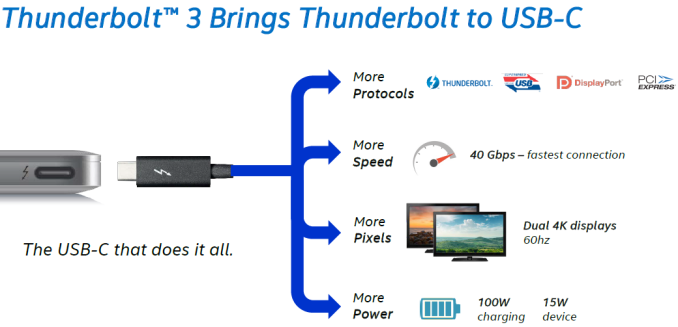
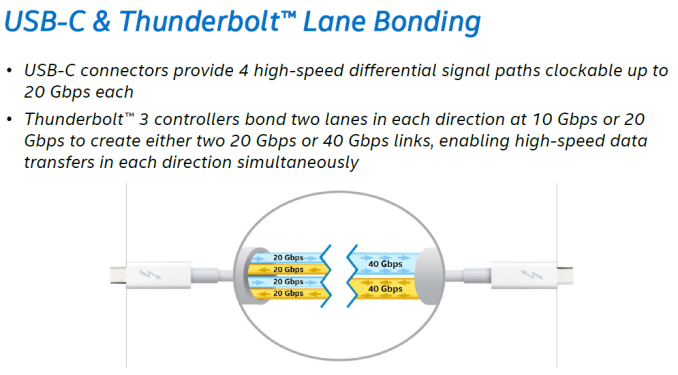
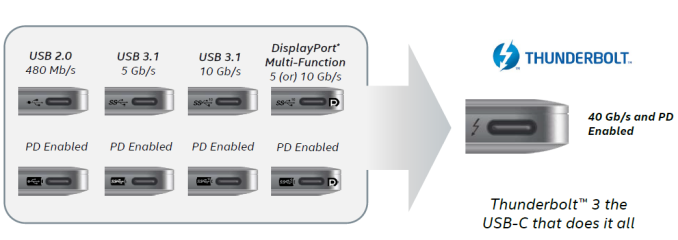
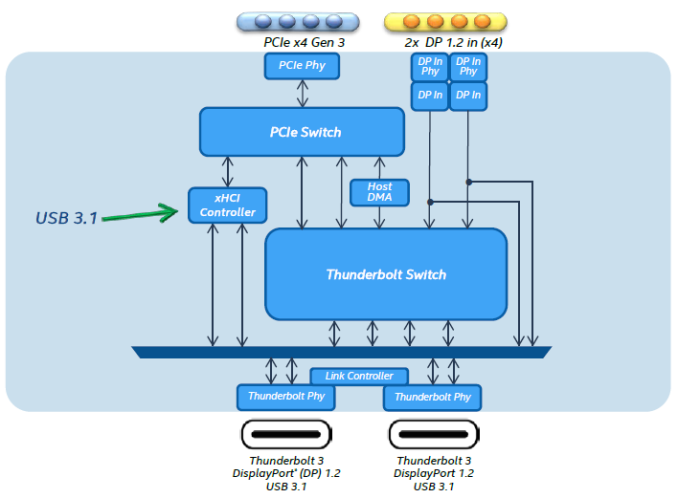
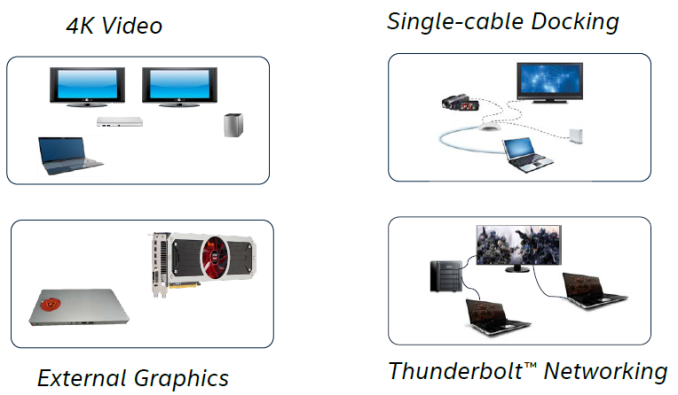








60 Comments
View All Comments
ganeshts - Saturday, April 16, 2016 - link
I would have agreed with you a year or so back, but the good thing here is that Thunderbolt has emerged successfully out of the Mac shadow. At present, every Thunderbolt 3 device out there is compatible with Windows only, and not Mac.From a system perspective, for a very little premium, board vendors can integrate USB 3.1 Gen 2 + Thunderbolt 3 into their notebooks and consumers can get more out of that integrated port compared to a pure USB 3.1 Gen 2 Type-C port. Whether that extra premium is worth it, the consumer should figure out. The board we used - GIGABYTE Z170 board with Alpine Ridge integrated - can be purchased for less than $200. I think at this price, compared to a vanilla system, consumers might be OK with something a bit more future-proof.
From a device perspective, yes, lots of Thunderbolt peripherals are overpriced. But, eGFX solutions will definitely be attractive to a lot of gaming folks who are looking for portability. Then, there is Thunderbolt networking which is attractive for small workgroups (more of a business use-case there). Daisy chaining is another great feature for thin systems.
Frankly, a year or two back, I wouldn't have been bullish on Thunderbolt, and would have equated it with Firewire. But, with Thunderbolt 3, I think Intel has finally converged on to the right type of solution.
theduckofdeath - Saturday, April 16, 2016 - link
Mobile gaming with an external GPU will stay a niche, as the bottleneck will still be the poorly cooled mobile technology within the notebook. Especially with DX12 and the likes, processor and motherboard component performance will be a lot more relevant than it has been since Microsoft introduced the hardware extraction layer to Windows last decade.And it's not just "some" TB accessories that are overpriced for what you get. Like the previous commenter said, you can build an actual PC for the price of this external case. Use it for storage if you like, or whatever else you'd want to use a spare PC for.
bobj3832 - Saturday, April 23, 2016 - link
I've worked in small offices with 6 people and huge corporations with over 100,000 employees. In every company we always had file servers on the network. Virtually no one kept data locally (except travelling sales people) If your workstation goes down just log in somewhere else and continue working.For my personal stuff at home I have a 10 gigabit network. The SATA interface (even for the SSDs I have in the file server) is the bottleneck.
I just don't have any need for Thunderbolt with a 10G network.
bobj3832 - Saturday, April 23, 2016 - link
And before someone complains of the cost I got used SFP+ cards for $20 each and a switch with 4 SFP+ ports for $520. It also has 24 1G ports.JHBoricua - Saturday, April 23, 2016 - link
Umm, and I had to log to the site to point how your comment on software raid was even more silly.What happens if the machine running a software RAID dies, you ask? Simple. Since it is software RAID, you simply mount the RAID volume on another PC running the same Os. That's the beauty of software RAID, it is not tied to the hardware.
Let me ask you this. What happens when the failed device happens to be this enclosure with its 'hardware' RAID? Well, you better have a spare one of the same make/model lying around or you won't be able to recover the data. But hey, you'll probably be able to use the same cable.
Seriously, did you even pause to think before commenting on the merits of software RAID vs this device?
damianrobertjones - Thursday, April 14, 2016 - link
I recall, all those years ago, that USB was supposed to feature daisy chaining.HideOut - Thursday, April 14, 2016 - link
Never. But I think firewire was. USB has always been hub + spoke layout. FW could chain I think.DanNeely - Thursday, April 14, 2016 - link
You could fake daisy chaining in USB by connecting hubs to each other; and in theory there was no reason you couldn't make a device with a 2port hub that used 1 port internally and exposed the 2nd for daisy chain type usage. Aside from a few higher end keyboards I've never seen anything like this done.FW had direct proper support for daisy chaining; but neither of the FW HDD enclosures I owned supported it.
hrrmph - Friday, April 15, 2016 - link
That's how most high-port-quantity USB hubs do it. They internally daisy chain. A "normal" USB hub is typically 4-ports. Use the last of those 4 ports to daisy chain to 4 more ports. The user sees a physical 7 ports on the outside of the hub.Vidmo - Thursday, April 14, 2016 - link
Waiting on the eight drive version to replace my current USB 3.0 local DAS backup solution. Backing up 36TB of data takes a long time over USB 3.0.